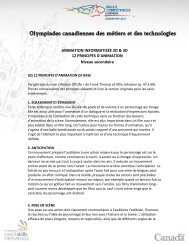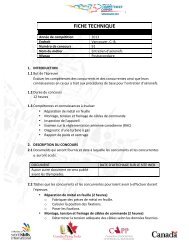Altivar 71 â Guide de programmation - Skills Canada
Altivar 71 â Guide de programmation - Skills Canada
Altivar 71 â Guide de programmation - Skills Canada
You also want an ePaper? Increase the reach of your titles
YUMPU automatically turns print PDFs into web optimized ePapers that Google loves.
[1.7 FONCTIONS D’APPLI.] (FUn-)<br />
UPd-<br />
Co<strong>de</strong> Nom / Description Plage <strong>de</strong> réglage Réglage usine<br />
USP<br />
nO<br />
LI1<br />
-<br />
-<br />
C101<br />
-<br />
-<br />
-<br />
Cd00<br />
-<br />
b [+ / - VITE]<br />
Fonction accessible si canal <strong>de</strong> consigne [Canal réf. 2] (Fr2) = [+/- Vite] (UPdt) voir page 114.<br />
Nota : Cette fonction n’est pas utilisable avec certaines autres fonctions. Respecter les précautions<br />
indiquées page 118.<br />
[Non] (nO)<br />
M [Affectation +vite]<br />
v [Non] (nO) : Fonction inactive<br />
v [LI1] (LI1) à [LI6] (LI6)<br />
v [LI7] (LI7) à [LI10] (LI10) : si carte entrées/sorties logiques VW3A3201 présente<br />
v [LI11] (LI11) à [LI14] (LI14) : si carte entrées/sorties étendues VW3A3202 présente<br />
v [C101] (C101) à [C115] (C115) : avec Modbus intégré en [Profil I/O] (IO)<br />
v [C201] (C201) à [C215] (C215) : avec CANopen intégré en [Profil I/O] (IO)<br />
v [C301] (C301) à [C315] (C315) : avec une carte <strong>de</strong> communication en [Profil I/O] (IO)<br />
v [C401] (C401) à [C415] (C415) : avec une carte Controller Insi<strong>de</strong> en [Profil I/O] (IO)<br />
v [CD00] (Cd00) à [CD13] (Cd13) : en [Profil I/O] (IO) commutable avec entrées logiques possibles<br />
v [CD14] (Cd14) à [CD15] (Cd15) : en [Profil I/O] (IO) commutable sans entrées logiques<br />
dSP<br />
nO<br />
LI1<br />
-<br />
-<br />
C101<br />
-<br />
-<br />
-<br />
Cd00<br />
-<br />
Str<br />
nO<br />
rA<br />
EEP<br />
Fonction active à l’état 1 <strong>de</strong> l’entrée ou du bit affecté.<br />
[Non] (nO)<br />
M [Affectation -vite]<br />
v [Non] (nO) : Fonction inactive<br />
v [LI1] (LI1) à [LI6] (LI6)<br />
v [LI7] (LI7) à [LI10] (LI10) : si carte entrées/sorties logiques VW3A3201 présente<br />
v [LI11] (LI11) à [LI14] (LI14) : si carte entrées/sorties étendues VW3A3202 présente<br />
v [C101] (C101) à [C115] (C115) : avec Modbus intégré en [Profil I/O] (IO)<br />
v [C201] (C201) à [C215] (C215) : avec CANopen intégré en [Profil I/O] (IO)<br />
v [C301] (C301) à [C315] (C315) : avec une carte <strong>de</strong> communication en [Profil I/O] (IO)<br />
v [C401] (C401) à [C415] (C415) : avec une carte Controller Insi<strong>de</strong> en [Profil I/O] (IO)<br />
v [CD00] (Cd00) à [CD13] (Cd13) : en [Profil I/O] (IO) commutable avec entrées logiques possibles<br />
v [CD14] (Cd14) à [CD15] (Cd15) : en [Profil I/O] (IO) commutable sans entrées logiques<br />
Fonction active à l’état 1 <strong>de</strong> l’entrée ou du bit affecté.<br />
M [Mémorisation Réf.]<br />
[Non] (nO)<br />
Associé à la fonction "plus vite / moins vite", ce paramètre permet <strong>de</strong> mémoriser la consigne :<br />
• lorsque les ordres <strong>de</strong> marche disparaissent (mémorisation en RAM)<br />
• lorsque le réseau d’alimentation ou les ordres <strong>de</strong> marche disparaissent (mémorisation en EEPROM).<br />
Sur le démarrage suivant, la consigne <strong>de</strong> vitesse est alors la <strong>de</strong>rnière consigne mémorisée.<br />
v [Non] (nO) : pas <strong>de</strong> mémorisation (sur le démarrage suivant la consigne <strong>de</strong> vitesse est la [Petite Vitesse]<br />
(LSP), voir page 40)<br />
v [RAM] (rAM) : mémorisation en RAM<br />
v [Eeprom] (EEP) : mémorisation en EEPROM<br />
137






